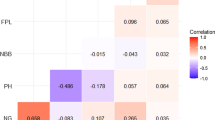Summary
Triple test cross-analysis was used to detect epistasis in chickpea. None of the characters investigated exhibited epistasis. In the absence of epistasis, additive and dominance effects were estimated. The results indicated the importance of additive genetic variance for seed yield, biological yield, number of primary branches, number of secondary branches, 100-seed weight, days to flower, and number of seeds per pod; dominance genetic variance for days to mature; and both additive and dominance genetic variances for plant height. Selection methods, such as pedigree and bulk, are suggested for the improvement of most characters.
Similar content being viewed by others
References
Bauman, L.F., 1959. Evidence of non-allelic gene interaction in determining yield, ear height, and kernel row number in corn. Agron. J. 51: 531–534.
Jinks, J.L., J.M., Perkins & E.L., Breese, 1969. A general method of detecting additive, dominance and epistatic variation for metrical traits. II. Application to inbred lines. Heredity 24: 45–57.
Kearsey, M.J. & J.L., Jinks, 1968. A general method of detecting additive, dominance and epistatic variation for metrical traits. I. Theory. Heredity 23: 403–409.
Ketata, H., E.L., Smith, L.H., Edwards & R.W., McNew, 1976. Detection of epistatic, additive and dominance variation in winter wheat (Triticum aestivum L. em Thell.). Crop Sci. 16: 1–4.
Lal, B., 1972. Diallel analysis of grain yield and some other quantitative traits in Bengal-gram (Cicer arietinum L.). M.Sc. Thesis, Punjab Agricultural University, Ludhiana, Punjab, India.
Rang, A., 1980. Genetic analysis of grain yield, its components and quality in chickpea (Cicer arietinum L.). Ph.D. Thesis, Punjab Agricultural University, Ludhiana, Punjab, India.
Singh, H., 1981. Competition and genetic analysis of yield factors in chickpea (Cicer arietinum L.). Ph.D. Thesis, Punjab Agricultural University, Ludhiana, Punjab, India.
Sprague, G.F., W.A., Russel, L.H., Penny, T.W., Horner & W.D., Hanson, 1962. Effect of epistasis on grain yield in maize. Crop Sci. 2: 205–208.
Stuber, G.W. & R.H., Moll, 1969. Epistasis in maize (Zea mays L.). 1. F1 hybrids and their S1 progeny. Crop Sci. 9: 124–127.
Yermanos, D.M. & R.W., Allard, 1961. The detection of epistatic gene action in flax. Crop Sci. 1: 307–310.
Author information
Authors and Affiliations
Additional information
Joint contribution from ICARDA, P.O. Box 5466, Aleppo, Syria and ICRISAT (International Crops Research Institute for the Semi-Arid Tropics), Patancheru P.O. 502 324, A.P., India.
Rights and permissions
About this article
Cite this article
Malhotra, R.S., Singh, K.B. Detection of epistasis in chickpea. Euphytica 40, 169–172 (1989). https://doi.org/10.1007/BF00023312
Received:
Issue Date:
DOI: https://doi.org/10.1007/BF00023312




